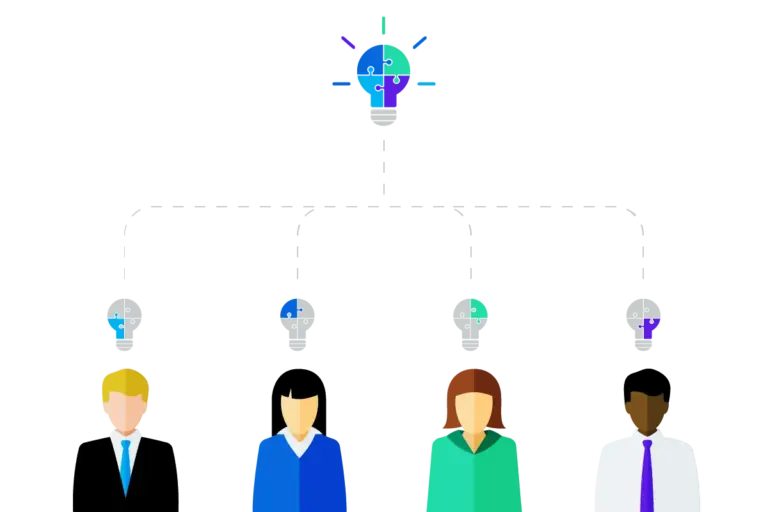Written by: Ruth D’Alessandro
Fact Checked by: Daniela Simson
What is workplace diversity?
A diverse workforce represents the world around us. This includes, but is not limited to, people from across the spectrum, of different genders, ethnicities, religions, ages, sexual orientation, physical abilities, neurodiversity, ideologies, and lifestyles.
Every employee will bring a different life experience, a different approach to problem-solving and a unique cultural contribution to your company. A diverse workplace offers an enriching experience for employees.
Free eBook: How to apply DEI to your employee experience program
Benefits of creating a diverse workforce
There’s strong evidence that a diverse workforce directly correlates to business success. One study by McKinsey & Co found that companies with ethnic diversity and racial diversity outperform their industry medians by 35%, and those with high gender diversity by 15%.
Diversity not only improves the bottomline, innovation, and overall employee value proposition, but as more millennials and centennials join the workforce, they categorically seek out employers that value diversity.They want to work for organizations that are diverse, inclusive, and socially responsible and failure to keep up might result in losing the war for talent.
In fact, 67% of jobseekers said workplace diversity was an important factor when choosing jobs to apply for. Another global survey by McKinsey found that 39% of respondents have turned down a job opportunity because of a perceived lack of inclusion.

There are numerous other benefits to diversity in the workplace, including:
Higher employee engagement
People who find their colleagues interesting and stimulating, and are included and treasured, will feel they belong, and engage more with their work. And engaged employees serve happy customers who in turn boost revenue.
Greater retention
Diverse workplaces are less likely to descend into toxic company cultures that alienate people and drive them to leave. Included, valued, loyal employees stay longer.
Higher productivity
Inclusive work environments bring in people with wide-ranging experience, skills, different perspectives and diverse backgrounds, helping teamwork, problem-solving and cooperation to thrive. Diverse teams learn from each other, leading to greater innovation and efficiency.
Deeper talent pool
Talent is equally distributed in the population so having a homogenous workforce means that you are losing out on top performers in the job market, creating an echo chamber.
Better customer relations
Employees who speak different languages, understand other cultures’ norms and values, or have had similar life experiences to your customers will be in a unique position to market your business to those sectors.
Brand equity
Your employer brand must be a positive, inclusive one if it is to succeed. You may not be seen as an employer of choice if the culture is in any way perceived or portrayed as biased. Today, ‘everyone’s a journalist’ with mobile phones and social media platforms; it only takes one viral TikTok to ruin a company’s reputation. There are more ways than ever to attract negative social media attention or bad press and do your brand irreparable harm.
Fewer skills shortages
When you employ diverse employees, they’ll bring a broad range of skills, some of which will surprise you. Many will be happy to retrain or upskill to make maximum use of their prior experience.
How to improve diversity in the workplace
1. Ensure that your recruitment team considers diverse candidates
To ensure a seamless and diverse hiring process, you need to start with your recruitment team. First and foremost, train your hiring managers and interviewers on how to conduct inclusive interviews and avoid unconscious bias.
Some of the ways you can make sure you reach diverse candidates include:
- Writing inclusive job descriptions: appeal to a wide range of job seekers with different backgrounds by using clear, unbiased and neutral language. Be wary of asking for qualifications or requirements that may exclude some candidate groups – focus instead on skills and experience. And highlight your organization’s diversity initiatives – ERGs (employee resource groups), mentoring or flexible working.
- Diverse sourcing: Consider a broader range of recruitment channels to access more diverse talent pools: social media, job boards, organizations and networks that support underrepresented groups such as LGBTQ+ people, ethnic minorities, veterans, or people with disabilities.
- Evaluating objectively: Use standardized and structured methods to assess candidates based solely on their abilities, skills and potential, rather than background or personal attributes. You can eliminate bias and make sure you’re fair and consistent in your hiring process by using an applicant tracking system (ATS), pre-employment tests and structured interviews.
2. Lead from the top down
It’s critical that you have diverse individuals as role models in leadership positions. After all, you cannot be what you cannot see. Diversity in the C-suite tends to trickle down and run throughout the rest of the company. It’s essential (and even necessary for compliance) that your board is diverse, to represent all employees and experiences.
3. Listen to your people
If you want to know what’s important to your people, ask them. Continual listening is crucial to identify and understand the areas that need improving. You can demographically segment your employee engagement surveys by minority groups, to make sure you don’t miss important issues affecting those groups.This is especially important when you conduct exit interviews: pay particular attention to the reasons why minority employees leave. The reasons minority groups leave are all too often left as ambiguous, e.g. for “personal reasons”, in order not to burn bridges.
Listening is key to understanding minority employees’ levels of engagement, their intent to stay, and their reasons for leaving companies.
Our DEI Solutions help you to assess if your processes are fair when you’re at the point of hiring, rather than waiting until your people leave.
4. Communicate actions and results
Once you’ve identified the areas of your DEI program that need improving, you must action them, and communicate the actions you’re taking to improve. According to our global study with more than 11,800 people, listening without action has been shown to be more detrimental to employee engagement than not listening at all.
5. Implement diversity and inclusion training
A diverse workforce begins with education, so equip your teams (and their leaders) with knowledge and skills. Focus on addressing things such as bias, workplace privilege and the experience of underrepresented groups as well as the usual legal and compliance requirements.
6. Emphasize benefits that attract diverse applicants
The opportunity for flexible or remote working, for example, may appeal more to working parents, students or people with disabilities. Floating holidays, where employees swap traditional public holidays for days that are culturally or religiously significant for them, are another diverse benefit.
A candidate experience program is your friend here. From seeing a job ad to onboarding, monitoring feedback gathered all along the candidate experience can tell you how applicants feel, so you can identify and address any gaps in your DEI strategy.
7. Thread inclusion throughout your company culture
Diversity is not just about creating a mix of people but actually getting them to feel at home and working at their best, bringing their authentic selves to work.
Before your new hires even walk through the door on their first day, it’s essential that teams and leaders are prepared to meet their new colleagues, and are made aware of any cultural considerations – what to do or not to do, and what to say and not to say – to help the new team member feel immediately at ease.
Then, to make sure every employee is welcome, respected for their uniqueness, and heard, you need to foster a feeling of belonging. This starts on the candidate’s very first day with a warm welcome, and throughout their time with the company. Ask your people what they like to do, and include these in team building activities, always mindful of any accessibility issues. When catering, take religious, cultural and medical considerations around meat, alcohol, dietary requirements and food preparation into account, to make sure everyone is included.
8. Include diversity in your company policy
Get your company approved as an Equal Opportunity Employer (EEO) and highlight this in your job ads. Don’t let your diversity policy reduce to small print: it should be a living document. Shout it loud and proud in your employee value proposition (EVP), company communications, newsletters, and on PR and social media channels.
9. Communicate
Make sure there are two-way communications set up, either with always-on feedback or regular pulse surveys that use inclusive language. Employees can keep conversations going, report diversity-related issues and make suggestions for improvements.
10. Build cultural agility
Invite speakers to share their stories and set up lunch and learn from different cultures. Let them share their history, stories, traditions, and what is important to them to educate others and initiate a deeper dialog about cultures and inclusiveness.
Research shows that minority employees found mentoring to be an important aspect of their career development, and important for attracting and retaining diverse talent.
How Qualtrics® can help improve workplace diversity
You want to create and embrace the best diversity culture possible throughout your organization. How can you get started?
Firstly, forget the idea that DEI is purely an issue for the HR department, and instead see it as a business imperative that makes the whole organization stronger. Use employee experience (EX) data to identify DEI gaps, easily view the most impactful actions you need to take, and actively create a more diverse and inclusive workforce.
Our DEI solution is part of our Qualtrics EmployeeXM® platform, which automatically identifies the actions business leaders can take to improve the everyday experiences of employees, so that they feel heard and respected, design a culture of belonging, and drive strategic business transformations.

It combines research-backed best practices paired with Qualtrics’ leading Employee Experience technology and can be either embedded into current employee experience programs, or run as a standalone program to:
- Empower your DEI leaders with research-backed and relevant methods: We include pre-built question sets and guides to help your leaders ask the right questions in the right way at the right times to get the most impactful insights from their teams.
- Deliver real-time insights to all managers: Using dashboard templates and action guides, leaders can easily view where they can have the most impact, what processes contain bias, and where to close diversity and inclusion gaps for employees across their teams. Analytics and prescriptive insights empower your managers to continually build a culture of belonging with their teams.
- Create flexible programs that adapt to your ever-evolving DEI needs: Your managers, executives, and other stakeholders can easily connect with HR systems to bring together operational (O) data and employee directories to the DEI programs. The flexible and dynamic survey and report builder makes evolving and personalizing your DEI program simple, fast, and customizable for your organization.
With our DEI solution you’ll be able to accelerate your DEI efforts with best-in-class technology combined with practical ways of measuring DEI progress.
Free eBook: How to apply DEI to your employee experience program